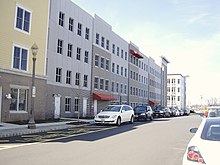User:Mendozarayadam/sandbox
Article Evaluation on New Urbanism[1]

Everything in the article is relevant to New Urbanism. The article mentions urban designs as being one of the things that strongly influences New Ubanism as well as some major concepts that derive from New Urbanism. The Two Concepts are, building a sense of community through identity and developing new ways to incorporate the environment into the design of a city.[1] There isn't much in this article that distracts from the main topic of New Urbanism. Overall, the New Urbanism article is mainly neutral. Right off the bat, the article mentions that New Urbanism is likes the idea that planners help make cities more functional with mixed use, more open spaces for recreation and adequate facilities, such as libraries, community centers and parks for anyone to use.[1] There are no over represented or underrated view points in the article. There is a good balance of information related to the concepts and idea of New Urbanism. Different architecture designs and developments that can typically associate with New Urbanism. The links and citations work and mostly link you to books, articles, case studies of previous works and educational institutes that are mostly related to new urbanism.[2] In the "Talk" section of the article, there are talks that address critical analysis on a how there are "no new urbanist development that is perfect" and continues to talk about how people send lots of time trying very hard to fix little things about new urbanism projects that may or may not be flaws depending on the project and how to avoid these flaws.[3] This article is a part of the Urban Studies and Planning, History, Sociology and Architecture Wiki Projects and all have had a part in editing the Wiki Article. The article was labeled as "C-Class Quality" on project scale according to the "talk" page of the article. The Urban Studies and Panning group rated the article as "mid-importance and the Architecture group rated the article as "high-importance."[4] The way the article explains the topics and concepts in the Wiki page compared to in class lecture is that there isn't much difference in terms of content since a lot of concepts we go over is pretty much similar. The main difference from the Wiki article in in class lecture are the examples. What I mean by this is that when we are in class we tend to stick to a couple of examples and go into as much detail when describing an idea or concept while on the Wiki page, there are a lot of examples and tend to be very similar to one another.
Puente Hills Landfill
The Puente Hills Landfill has been in operation for more than 50 years and was one of the nation's largest landfills. The Puente Hills Landfill was officially shut down in October 31, 2013; however, the landfill still had different waste materials that needed to be placed there until LA county found other facilities that would take in the other waste materials. At times, the landfill would have trash and other waste material piled up as high as 500 ft. According to LA County's Parks and Recreation Department, the landfill is currently covered with soil and has plans of being turned into a park one day. One potential positive idea that came from the shut down of the landfill is the methane gas that the city of Puente Hills wishes to use the methane as a heat source where it is converted to steam which would help power turbines and create 50 megawatts of electricity. 50 Megawatts of electricity is supposedly enough to power 70,000 homes which Puente Hills can definitely benefit from. [5][6][7][8][9][10][11]
 | This is a user sandbox of Mendozarayadam. You can use it for testing or practicing edits. This is not the sandbox where you should draft your assigned article for a dashboard.wikiedu.org course. To find the right sandbox for your assignment, visit your Dashboard course page and follow the Sandbox Draft link for your assigned article in the My Articles section. |
- ^ a b c "New Urbanism". Wikipedia. 2018-03-12.
- ^ "Talk:New Urbanism". Wikipedia. 2018-02-17.
- ^ "Talk:New Urbanism". Wikipedia. 2018-02-17.
- ^ "Talk:New Urbanism". Wikipedia. 2018-02-17.
- ^ Fickes, Michael (July 2005). "TRASH ON SPEED. (cover story)". Waste Age 36. no. 7: 28-36.: 5 – via EBSCOhost.
{{cite journal}}:|volume=has extra text (help) - ^ Raflo, Brook (October 2000). "L.A. County Purchases Peace of Mind". Waste Age 31. no. 10, 44: 2 – via ebscohost.
{{cite journal}}:|volume=has extra text (help) - ^ Kanakri, Terry (March 2, 2017). "The Transformation of the Puente Hills Landfill". National Recreation and Park Association.
- ^ Humes, Edward (March 5, 2013). Garbology: Our Dirty Love Affair with Trash. Penguin Group. ISBN 978-1583334348.
- ^ Wicker ( Director ), John; Garcia (Chief Deputy Director), Norma E. (October 25, 2016). "Parks Make Life Better!" (PDF). County of Los Angeles Department of Parks and Recreation.
- ^ West, Amanda C. "The Puente Hills Habitat Authority: A Preservation Success Story" (PDF). Puente Hills Landfill Native Habitat Preservation Authority.
- ^ "Download Limit Exceeded". citeseerx.ist.psu.edu. CiteSeerX 10.1.1.384.8246. Retrieved 2018-05-02.
